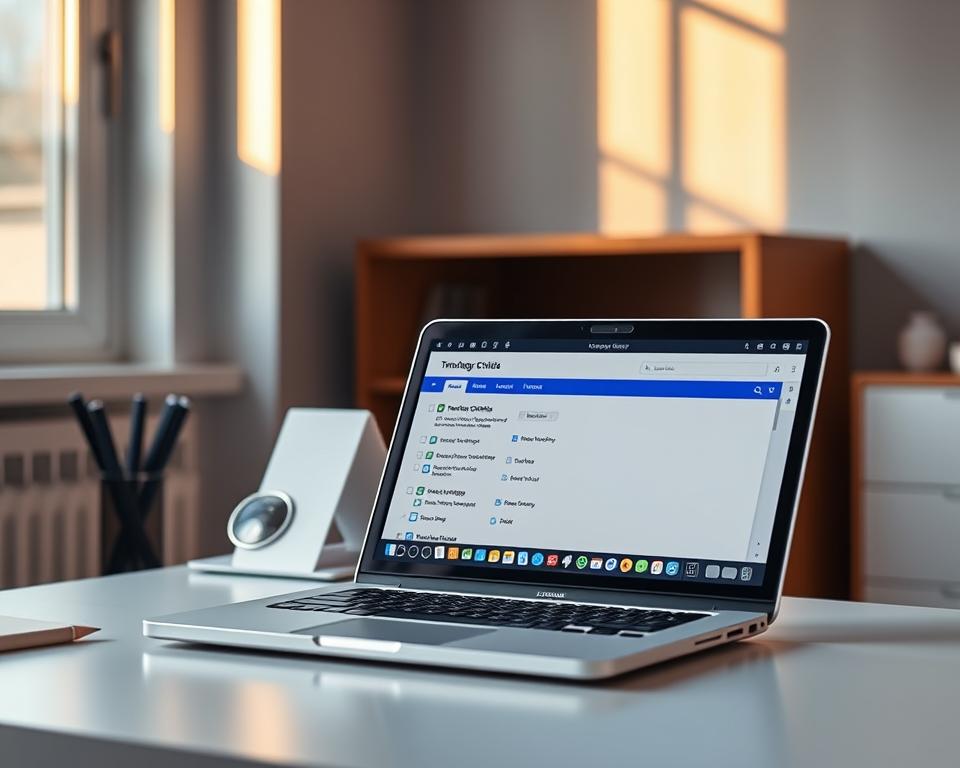Anúncios
Technology checklist is often the first thing you see when preparing for campus life, but do you know which steps really matter before class starts?
This short guide explains why schools now expect secure sign‑ins, updated devices, and steady networks. Universities in the United States and services like UK ITS publish a student tech list that helps newcomers set up essentials. Macalester College and others host a clear page that points you to what to install and what to skip.
You’ll learn what to set up first, how to avoid common delays, and what gives you reliable access on day one. The guide shows practical clicks, settings, and overlooked items so you move quickly and with confidence.
Be curious but careful: adapt these steps to your gear, check your school’s official pages, and use reputable sources before choosing tools. Explore trends and tools responsibly and verify details with your institution’s support if you hit a snag.
Introduction to your Technology checklist
A short plan saves hours and keeps you from losing access when you need it most. Universities publish a student tech list to cut first‑week delays and reduce troubleshooting.
Context and why this matters now
You use many logins for email, cloud, and learning systems. A missed step can lock your account or block access to important campus resources.
Cyber risks and policy updates make stronger password habits and modern authentication essential, especially on personal devices.
What you’ll simplify with this checklist
This guide groups tasks so you update devices, install core apps, and register connections without repeating steps. That saves time and cuts errors.
Who this guide helps and how to use it
The guide fits new and returning student users, staff, and anyone preparing a laptop for school or work. Move section by section and check items off as you go.
If your campus has specific directions, pause and follow those instructions before continuing.
Staying safe and responsible as you set up
Use official download sources, read permissions before you install an app, and avoid saving credentials in untrusted places.
Keep personal and academic data separate, review sharing defaults, and contact IT with specific error details and timestamps when you need help.
Technology checklist: the essentials you should set up first
Start with a few high‑impact steps that lock down your accounts and get your devices ready for class. These quick wins save time and protect your work.
Secure your accounts: sign in to your primary email and cloud. Confirm recovery email and phone. Check recent sign‑ins and sign out old sessions on shared devices.
- Strong passwords: use long passphrases you can remember (four random words with separators). Avoid personal trivia.
- Password managers: consider a reputable manager to generate and store credentials securely.
- Multi‑factor: enable authentication for email, bank, and learning systems. Prefer app prompts or security keys over SMS. Save backup codes offline.

Prepare your laptop: run OS, driver, and firmware updates. Free at least 20% storage and check battery health. Replace swollen batteries at an authorized center.
Install core software: get a modern browser, an office suite your school supports, a PDF reader, and reputable antivirus from official sources. Enable auto‑updates.
Network and data: secure your home Wi‑Fi with a strong admin password and WPA2/3. Use a trusted hotspot if needed. Turn on device encryption and set up a 3‑2‑1 backup plan.
Quick tip: install your campus app, email, calendar, and an MFA authenticator so you get critical alerts and steady access on the go. For a full setup list, see this essential setup guide.
Student-focused setup: campus accounts, access, and support
Handle account activation and network access early to avoid last‑minute hurdles on campus. Start with your campus account and student email so messages reach you right away.
Activate your campus account and student email address
- Complete identity steps and set a secure initial password.
- Claim your student email address and send a test message.
- Set recovery options and confirm your display name and mailbox address.
Enroll in MFA and test sign‑in from a laptop and phone. Keep at least two factors registered, like an authenticator app and a security key.
Connect to campus Wi‑Fi and register devices
Use the secure SSID your school names. Register non‑browser devices if the portal requires it. Set reminders for re‑auth so your network access stays active.
Learning systems, library services, and printing
Log in to your LMS, library page, and printing portal early. Test off‑campus access (proxy or VPN) so you can reach journals and e‑books when needed.
Tech help and software access
- Save the IT service phone, email, and walk‑in hours.
- Bookmark the knowledge base and include device type, OS, and screenshots when you request help.
- Use the campus license portal to download software and plan big updates when you have power and a stable network.
Always check your official campus pages for exact steps and follow campus guidance for secure access.
Conclusion
Wrap up your setup by turning these steps into habits that protect accounts and save time. Treat this guide as a starting checklist and adapt it when your needs change.
Verify actions with official campus IT pages and knowledge bases before you install a new app or change critical settings. That keeps your work aligned with school policies and support options.
Build small routines: review sign‑in alerts weekly, prune unused apps monthly, and rotate passwords on a sensible schedule. When something fails, document symptoms, note recent changes, and contact support with clear details.
Keep learning responsibly and adjust your setup as tools evolve. A simple, secure approach serves you best as a student entering the semester.



